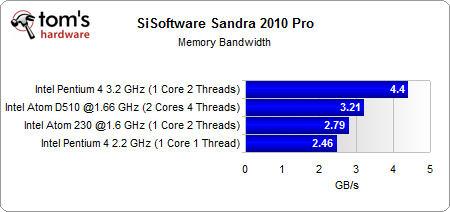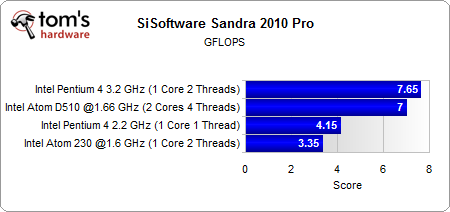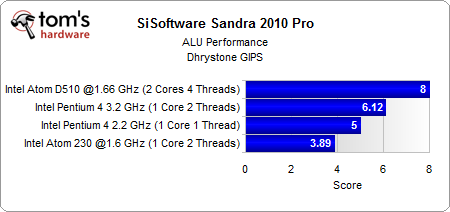Reply 20 of 27, by smeezekitty
The Tom's review by itself invalidates this statement, with the 2.2GHz P4 outperforming both Atom offerings in a variety of benchmarks, and the Passmark scores support that assertion as well (and for what feels like the millionth time: you CAN NOT take the "overall" passmark score when comparing multi-core to single-core processors).
No it doesn't. The Atom they are comparing has a 600MHz clock deficit. That is huge.
Pentium 4 1.6GHz Passmark Single-core: 344 Pentium 4 2.4GHz Passmark Single-core: 564 Atom N270 Passmark Single-core: 240 Atom D […]
Pentium 4 1.6GHz Passmark Single-core: 344
Pentium 4 2.4GHz Passmark Single-core: 564
Atom N270 Passmark Single-core: 240
Atom D510 Passmark Single-core: 266My original statement of 30% is based on the 1.6GHz P4 vs the Atom D510 - it's 29.3% faster, but it's easier to just round that off for the sake of conversation.
Where are you even getting these numbers?
http://www.cpubenchmark.net/low_end_cpus.html
Lets keep it simple by keeping dual core out of the equasion.
The Atom Z530 is single core, 1.60 GHz and has a TDP of 2W (!)
It scores 281 in passmark.
Above it a Pentium 4 2.60GHz scores 291. That is 10 more points for a whole gigahertz more of clock.
Despite the wall of text trying to defend it, again P4 really sucks it.
At 120x the power consumption. And if you are going to run DDR2 and PCI-E then why not just run Core2?
Atom D510 is 13W TDP. 120*13 = 1560W. 🤣 On it's absolute worst day even a Pentium 4 Extreme Edition will barely scratch at 1/10th of that. The 1.6GHz and 2.4GHz chips mentioned thus far are about half of that - 50-70W TDPs, versus the 100W+ of later Prescott models. As far as picking power efficiency goes, the Celeron on the linked board has a TDP of 19W, and that's not too far away from a P3. Just using my 1GHz CuMine as an example, it has a TDP of 29W. Performance wise I wouldn't expect them to be all that far apart for our purposes, and if you need the additional expansion (especially ISA) the P3 will make more sense. If we're only talking about games that need a Voodoo3 (or for which a Voodoo3 is overkill), the Celeron, P3, etc are much more efficient choices - their performance difference to a P4, Core 2, Core i7, etc whatever will be largely irrelevant.
[/quote]
The Atom Z530 (launched in 2008!) has a 2W TDP. I was wrong about 120x the power consumption but 30x is about right.
If you're wanting to step up to DX8/DX9 gaming, and are worried about power efficiency, Pentium M is a fine choice versus Athlon64 or Pentium 4. A Core 2 would also work fine, and may even become required depending on how far into the future you need to go.
+1
A Pentium M or Core 2 is both more efficient and still fast. If you need ISA, you would be better off with a P3 chip
My point in bringing up expansion options for the P4 wasn't really aiming at that though - it's more that Atom, and other integrated solutions (like the Celeron ITX linked, or the VIA ITX boards, etc) lack expansion options relative to more conventional desktop platforms, which can limit their suitability for gaming. For example in the Tom's comparison, it's no contest in 3DMark between the Pentium 4 and Atom systems, simply because the Pentium 4 systems can have a Radeon X800 installed in them, which is substantially faster than the Intel GMA. Core 2 is of course a better choice than Pentium 4, when available, and has all of the same basic advantages over a mostly integrated platform. Pentium M *can be* as good, as there are some Pentium 4 motherboards (like P4P800) that will support it, as well as motherboards designed exclusively for it (like the DFI in the TechReport article). For our purposes here, which are primarily gaming related, this is probably more pertinent than absolute power efficiency of a highly integrated ITX machine vs a conventional desktop. Of course if the ITX machine will meet all of your needs, go ahead and save the power and complexity. 😀
Which it in itself makes it a very unfair test. I don't know about what the Atom boards have available but I came across some mini-itx boards that had a PCI-E x16 slots
allowing just about any GPU to be used.
Again, you cannot take the "overall" Passmark score when comparing multi-core to single-core processors or single-threaded performance, because Passmark is unevenly weighted towards multi-thread execution. Nobody is arguing that in an ideal, modern, parallelized workload the dual-core Atom is at a disadvantage to a single-core Netburst (although the Tom's article does show some situations where the P4 outperforms the dual-core Atom). But that kind of performance is largely irrelevant here - none of these chips are going to be fast enough for games that require multi-core processors, and for older games (like would run on a Voodoo3, from the original post) single-threaded performance is all that you have to worry about.
I was looking at the single core Atoms so that is moot
Your own SINGLE CORE Atom N270 gets 282. The D510 has a SINGLE CORE rating of 266. Even taking the best P4 score and the worst atom one that is a clear win for the Atom.
The "best" P4 score, coming from the Pentium D 965 (it's the fastest/highest-spec NetBurst - if you have another meaning for "best" please clarify) is an overall rating of 1000, and a single-thread score of 845. The D510's single thread rating is 266, and "overall" is 667. In both cases the EE 965 is consistently higher. See above for the comparison numbers for the 1.6GHz, 2.4GHz, D510, and N270. The Mobile 1.6GHz achieves a single-core rating of 392, which is better than the desktop variant (344; to save scrolling). As a side note: mobile Pentium 4s are potentially dubious to use as benchmark sources, because many laptops with P4m will end up aggressively throttling due to heat (there's a thread in System Specs that explores this somewhat). This isn't to say P4m always performs badly, just that there seems to be more potential for variation between P4m-based machines due to throttling.
[/quote]
Its irrelevant. Of course a 3 GHz+ P4 will beat a 1.6GHz Atom. The question was per clock performance
I'm not seeing a "clear win" here - it instead looks like you're cherry-picking data to perpetuate an argument. And remember: none of this actually matters for this thread/discussion. The ITX board in question has a Core-based Celeron, the Celeron 220. That chip has a Passmark single-thread rating of 427, putting it well ahead of anything that's been mentioned here short of the EE 965 and 2.4GHz P4. And it's far more power efficient than either of those chips.
And you are not cherry picking?
I do agree on the Core2 celeron though. It will shred just about anything discussed here.


